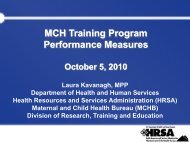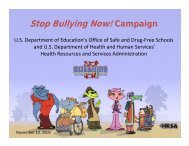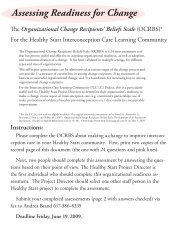Pediatric Case Studies - HRSA
Pediatric Case Studies - HRSA
Pediatric Case Studies - HRSA
Create successful ePaper yourself
Turn your PDF publications into a flip-book with our unique Google optimized e-Paper software.
PEDIATRIC CASE STUDIES: EMERGENCY DEPARTMENT TRIAGE<br />
Instructions<br />
Please rate the Emergency Severity Index (ESI) level for each case study (levels 1-5).<br />
Use the ESI V.4 algorithm to rate the cases.<br />
1) A 16-year-old male wearing a swimsuit walks into the emergency department. He<br />
tells you that he dove into a pool and his face struck the bottom. You notice an<br />
abrasion on his forehead and nose as he tells you that both of his hands “feel tingly”.<br />
He is alert, anxious, pale, diaphoretic and breathing 28/min. Heart rate is 50.<br />
2) 8 month old baby girl brought to the ED by Mom who tells you that she thinks her<br />
baby has chicken pox. Infant is sleeping in mom’s arms. You note a rash on her chest<br />
and belly that does not blanch; she feels cool to your touch. T 99F (37.2 C) HR 190 RR<br />
24.<br />
3) You are trying to triage an 18 month old whose father brought him the ED for<br />
vomiting. The child is very active and trying to get off his father’s lap to play with your<br />
equipment. His father distracts him with a sippy cup which he happily drinks from. T<br />
37.2 (100F) HR 122 RR 22.<br />
4) I think my son has swimmer’s ear. He spends most of the day in the pool with his<br />
friends, so I’m not surprised” the mother of an otherwise healthy 10 year old tells you.<br />
The child has no complaints except for painful itchy ears.<br />
T 36.8 (98.3F) HR 88 RR 16.<br />
5) “The smoke was so bad; she’s been having trouble breathing ever since” reports the<br />
father of a 6 year old girl who ran into her burning house to try and rescue her cat. She<br />
is hoarse, has a cough, is audibly wheezing and is breathing 50 times a minute. Work<br />
of breathing is labored and SpO2 is 82%. History of asthma, uses inhalers when<br />
needed.<br />
6) A 17 year old male is brought in by his mother after falling off his bike. He says his<br />
right wrist hurts and rates the pain as a 5 on a 1-10 scale. His hand is warm with<br />
normal sensation and he is able to move his fingers. “Thank goodness he had his<br />
helmet on" his mother tells you.<br />
7) “I think he has an ingrown toenail” reports the mom of a healthy 11 year old boy.<br />
The boy tells you “It started hurting last week” and today he noticed” it was red and<br />
swollen”. Big toe on right foot looks mildly swollen and red around the nail. He has an<br />
appointment with his family doctor the following day that his mother does not think she<br />
can take him to. T 98.8 (36.1 C), HR 82, RR 18 BP 108/70.<br />
8) A 17-year-old handcuffed male walks into the emergency department accompanied<br />
by the police. The parents called 911 because their son was out of control: verbally and<br />
physically acting out and threatening to kill the family. He is alert, cooperative at triage<br />
Funded by Grant H34MCO4371 From the Health Resources and Services Administration/<br />
Maternal and Child Health Bureau’s Emergency Medical Services for Children Program.<br />
© 2010 University of North Carolina at Chapel Hill<br />
1
PEDIATRIC CASE STUDIES: EMERGENCY DEPARTMENT TRIAGE<br />
and answers your questions appropriately. He is currently taking no medications. T<br />
98F (36.7 C) HR 82 RR 14 BP 128/80.<br />
9) EMS radios to say they are en route with a 5 year old girl who aspirated a balloon at<br />
a birthday party. She is alert but drooling and unable to speak. HR 124 RR 28 sat 99%<br />
on blow by oxygen.<br />
10) “I just realized my son is out of his asthma medicine and we’re going on vacation in<br />
the morning, can you give him some more just in case he needs it?" The father of a 6<br />
year old boy asks you. The child is climbing on and off his father’s lap and playing with<br />
your blood pressure cuff. He has good color and is breathing comfortably. His father<br />
says he has not been sick or wheezed recently.<br />
11) A 9-year-old boy presents to the emergency department with his parents who<br />
request he be checked because he has a severe shellfish allergy and he mistakenly ate<br />
a dip that may have contained shrimp. Mom says she administered the child’s epi pen.<br />
The boy tells you that he feels ok, just “kind of shaky”. No wheezes or rash noted. T 97<br />
(36.1 C) HR 118, RR 20, SpO2 97% BP 116/74.<br />
12) “She keeps running to the bathroom” says the grandmother of an 8-year-old girl.<br />
Grandma requests to see a doctor because she thinks the child has a possible urinary<br />
tract infection. The child says “it hurts to pee”. She says her tummy doesn’t hurt and<br />
Grandma says she hasn’t noticed anything different about child’s underwear when you<br />
ask about vaginal discharge. T. 97.4 (36.3 C), HR 88, RR 20, BP 122/70.<br />
13)A 3 year old boy is brought to triage by his mom who tells you he cut his hand on a<br />
glass while he was trying to help her wash the dishes. You note a 3 cm jagged cut on<br />
his hand with no active bleeding. When you try to examine the wound he screams and<br />
pulls away, trying to hit you with his other hand. T 98 (36.7 C) HR 110 RR 26 BP<br />
100/68.<br />
14) A two year old is brought in by his mother for a fever. She states that he has been<br />
fussy at home and eating less than usual but is drinking well. She tells you that she<br />
thinks immunizations give you autism and her son has not had any of his shots. The<br />
child is fussy but alert, with no obvious source for his fever on your exam. T 39<br />
(102.2F) HR 140 RR 24 sat 98% RA.<br />
15) He has rashes on his asses” the mother of a 14 month old boy tells you. The child<br />
is alert, playful, is breathing normally and has good color. When you remove his diaper<br />
to take his temperature, you note that his buttocks are reddened and he has a macularpapular<br />
rash. The rash is only in his diaper area. His diaper is slightly wet. T 99 (37.2<br />
C) HR 110 RR 26.<br />
Funded by Grant H34MCO4371 From the Health Resources and Services Administration/<br />
Maternal and Child Health Bureau’s Emergency Medical Services for Children Program.<br />
© 2010 University of North Carolina at Chapel Hill<br />
2
PEDIATRIC CASE STUDIES: EMERGENCY DEPARTMENT TRIAGE<br />
16) A woman brings in her 12 year old son because he stepped on a rusty nail in their<br />
barn. The child says his foot hurts and he thinks a piece of the nail is still in it. His last<br />
tetanus shot was at 4 years of age.<br />
17) “I just turned my back for a minute” cried the mother of a four year old. The child<br />
was pulled out of the family pool by a neighbor who immediately administered mouth-tomouth<br />
resuscitation. The child is now breathing spontaneously but continues to be<br />
unresponsive. On arrival in the emergency department vital signs were: T 96F (35.5C)<br />
HR 126, RR, 28, BP 80/64, SpO2 91% on a non-rebreather mask.<br />
18) A 1 month old infant girl is carried into triage in a child safety seat by her parents.<br />
They tell you that “baby sick” but are otherwise unable to understand your questions or<br />
give you any more information as they do not speak or understand your language. The<br />
baby appears to be sleeping, respirations quiet, color normal. You notice some<br />
yellowish liquid on the baby’s blanket next to her face. T 98 (36.7 C) HR 130 RR 30.<br />
19) A 15 year old girl is brought in by her mother who says that the child has been<br />
sleeping all day and refusing to go to school for the past week. This morning she said<br />
she was going to run in front of a car because she’d rather be dead. The child is alert<br />
and quiet. She does not make eye contact with you and refuses to answer your<br />
questions.<br />
20) A 4 year old girl is transported to the ED following a fall off the jungle gym at<br />
preschool. A witness reports that the child hit her head, and was unconscious for a<br />
couple of minutes. On arrival you notice that the child’s left arm is splinted and that she<br />
is very sleepy and arouses only with noxious stimuli. T 97.8 (36.6 C) HR 162, RR 38.<br />
21) A nine year old male tells you he fell on the playground at recess. He has a 3 cm<br />
laceration over his right knee. He is otherwise healthy, has no allergies and his<br />
immunizations are up to date.<br />
.<br />
22) A very angry father of a 3 year old boy carries his son to triage telling you that he<br />
just picked his son up after a weekend visit with his mother and that he is sure that the<br />
child has been “messed with”. He refuses to sit down with the child so that you can<br />
obtain vital signs and tells you that he better get to see the doctor NOW. The child is<br />
alert, breathing normally though he is crying, and has good color.<br />
23) “The pediatrician sent us to the Emergency Department because my son may have<br />
appendicitis” reports the mother of a previously healthy seven year old boy. “He woke<br />
up this morning with a tummy ache. He hasn’t wanted to play or eat and he threw up all<br />
over the doctor’s office.” The child is sitting quietly holding an emesis basin. T 37.9<br />
(100.2F) HR 94 RR18 BP 103/62.<br />
Funded by Grant H34MCO4371 From the Health Resources and Services Administration/<br />
Maternal and Child Health Bureau’s Emergency Medical Services for Children Program.<br />
© 2010 University of North Carolina at Chapel Hill<br />
3
PEDIATRIC CASE STUDIES: EMERGENCY DEPARTMENT TRIAGE<br />
24) 7 year old boy limps into triage. He tells you “I hurt my foot when I fell off of my<br />
skateboard”. He says it hurts when he walks; you notice swelling over the medial<br />
aspect of the ankle. T 96.8 (36 C) HR 90 RR 22 BP 102/60.<br />
25) A nine day old is brought in by EMS after the family called to say she had stopped<br />
breathing and her lips turned blue. The child was pink, alert and crying when EMS<br />
arrived. She is currently sleeping comfortably in a car seat. T 37.3 (99F) HR 144 RR28<br />
sat 99% on RA.<br />
Funded by Grant H34MCO4371 From the Health Resources and Services Administration/<br />
Maternal and Child Health Bureau’s Emergency Medical Services for Children Program.<br />
© 2010 University of North Carolina at Chapel Hill<br />
4
PEDIATRIC CASE STUDIES: EMERGENCY DEPARTMENT TRIAGE<br />
Answer Key<br />
1. Level 1. This young man has significant mechanism of injury with symptoms of<br />
spinal cord injury and neurogenic shock. He will need immediate life-saving<br />
intervention of spinal immobilization and airway management.<br />
2. Level 2. This child has classic symptoms of meningococcal sepsis; she has a<br />
non-blanching rash and her heart-rate and “coolness” to touch are early signs of<br />
shock. Infants often do not have hyperpyrexia when septic as they have<br />
relatively immature thermoregulatory systems. Some children may appear to be<br />
“sleeping” when they are actually unresponsive. This child is High Risk and<br />
should be placed in the treatment area.<br />
3. Level 5: No resources. This child is well hydrated and active. He will need a<br />
physical exam and his father will need reassurance and teaching about oral<br />
rehydration.<br />
4. Level 5: The child will need a physical exam and a prescription for ear drops. If<br />
the drops are administered in the ED that does not count as a resource.<br />
5. Level 1. This child has obvious signs of impending respiratory failure: tachypnea,<br />
labored breathing and hypoxia. She will need immediate life saving treatment<br />
with endotracheal intubation and ventilatory management.<br />
6. Level 4: One resource. X-rays will be needed to evaluate for a fracture. If a<br />
splint is placed, that is not considered a resource. If his pain were >7 out of 10<br />
you would need to consider making him an ESI 2. If his wrist appeared deformed<br />
or if there were neurovascular compromise he would require a higher acuity level<br />
as well.<br />
7. Level 4. Although this child has a doctor’s appointment, he is now in the ED and<br />
will likely receive an exam and a simple procedure of excising the toenail. He is<br />
not likely to need sedation or any further diagnostics.<br />
8. Level 2. While this young man may seem to be under control at the moment, he<br />
is still a High Risk patient. He has a history of recent violent behavior. Just<br />
because someone is in handcuffs does not mean they are not still dangerous.<br />
9. Level 1. Life-threatening situation. This girl’s airway is not occluded, but could<br />
become that way if the balloon is not rapidly removed from her throat. You would<br />
not want to “do” anything in triage as causing further agitation may cause the<br />
Funded by Grant H34MCO4371 From the Health Resources and Services Administration/<br />
Maternal and Child Health Bureau’s Emergency Medical Services for Children Program.<br />
© 2010 University of North Carolina at Chapel Hill<br />
5
PEDIATRIC CASE STUDIES: EMERGENCY DEPARTMENT TRIAGE<br />
child to cry or struggle and the danger of the balloon occluding her airway would<br />
be even greater. Even if you do not have a bed for this child you would get her to<br />
the treatment area immediately.<br />
10. Level 5: No resources. The child just needs a physical exam and a prescription<br />
refilled which are not resources.<br />
11. Level 2. This child is a High Risk patient; he has a significant history of<br />
anaphylaxis and even though he appears to be stable at this time, biphasic<br />
reactions account for 50% of deaths in anaphylaxis.<br />
12. Level 4: One resource-laboratory (UA/C&S); exam and prescription. (The exam<br />
and Rx are not resources. If the first dose of antibiotics is given in the ED, that is<br />
not a resource either unless it is given parenterally).<br />
13. Level 3: This patient is going to require multiple resources. He will need the<br />
wound repaired, for which he will likely need sedation and he may also need an<br />
x-ray to evaluate for a retained foreign body.<br />
14. Level 3. This child meets the latest ESI 4 guidelines of a Level 3 pediatric<br />
patient. He has a fever, incomplete immunizations and no obvious source of<br />
infection.<br />
15. Level 5: The child needs an exam and may need a prescription for a topical<br />
antifungal (prescriptions do not count as a resource).<br />
16. Level 3: More than one resource. The child will need an x ray of his foot and<br />
removal of the foreign body. He will also need a tetanus shot but that is not<br />
counted as a resource.<br />
17. Level 1. This child has significant mechanism of injury with clear neurological<br />
complications. Given the unresponsiveness and hypoxia on a non rebreather the<br />
child is in need of immediate airway management.<br />
18. Level 2. This infant, really a neonate, may simply be spitting up formula, and<br />
have inexperienced parents, but because she can’t tell you what is wrong and<br />
neither can the parents due to their inability to communicate with you properly in<br />
triage, she is a High Risk patient. In triage you cannot rule out more serious<br />
causes of the vomiting (such as a malrotation or pyloric stenosis) without better<br />
history and assessment. You would not want this infant waiting in your waiting<br />
area.<br />
Funded by Grant H34MCO4371 From the Health Resources and Services Administration/<br />
Maternal and Child Health Bureau’s Emergency Medical Services for Children Program.<br />
© 2010 University of North Carolina at Chapel Hill<br />
6
PEDIATRIC CASE STUDIES: EMERGENCY DEPARTMENT TRIAGE<br />
19. Level 2. High risk situation. The patient is depressed and expressing suicidal<br />
thoughts. She should be considered a danger to herself and should not be left<br />
alone or in the waiting room.<br />
20. Level 1. This child has an altered mental status after a significant, witnessed,<br />
closed head injury. She is also tachycardic and tachypneic and may have<br />
pulmonary contusions or internal bleeding.<br />
21. Level 4: One resource. The laceration will require suturing (a simple procedure).<br />
If the child were younger or uncooperative he might need sedation for the repair<br />
which would make him an ESI 3.<br />
22. Level 2. Although this child appears to be in no distress, we are also triaging the<br />
father in this case. The triage nurse, the child, other patients and staff are at risk<br />
of being harmed by this father. Calling security or an outside police agency may<br />
be a possibility, but it would not be prudent to allow this family to wait in the<br />
waiting area.<br />
23. Level 3: Two or more resources. This child will likely require labs, IV fluids and<br />
diagnostic tests such as ultrasound or CT scan.<br />
24. Level 4: This patient will require one resource (an x-ray). He may need a splint<br />
or crutches, but those are not resources. If his ankle were deformed or an<br />
orthopedic consult is routine for all fracture patients at your institution he would<br />
be a level 3.<br />
25. Level 2: This is a high risk situation. This child had an apparent life threatening<br />
event (ALTE) at home, and while it may have been due to a benign cause (such<br />
as reflux), you need to rule out more serious problems such as sepsis, seizures<br />
or cardiac disease. This infant will need multiple diagnostic tests and admission<br />
to the hospital.<br />
Funded by Grant H34MCO4371 From the Health Resources and Services Administration/<br />
Maternal and Child Health Bureau’s Emergency Medical Services for Children Program.<br />
© 2010 University of North Carolina at Chapel Hill<br />
7


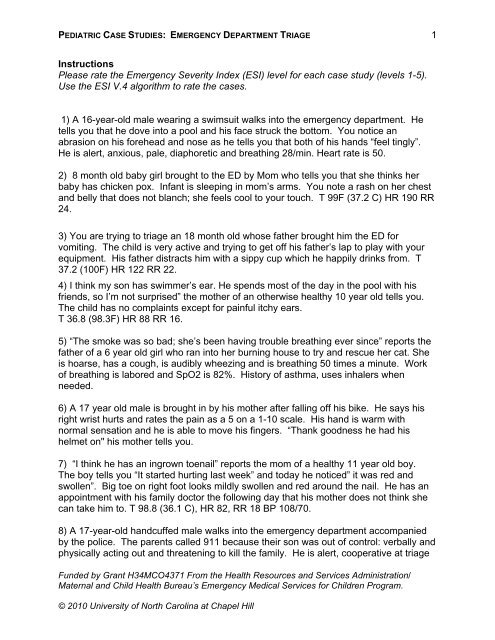

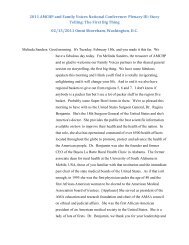



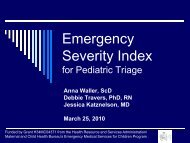
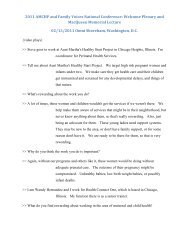
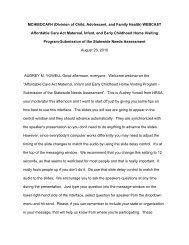
![Hormone Disruptors and Women's Health: Reasons for Concern [PDF]](https://img.yumpu.com/19410002/1/190x245/hormone-disruptors-and-womens-health-reasons-for-concern-pdf.jpg?quality=85)

